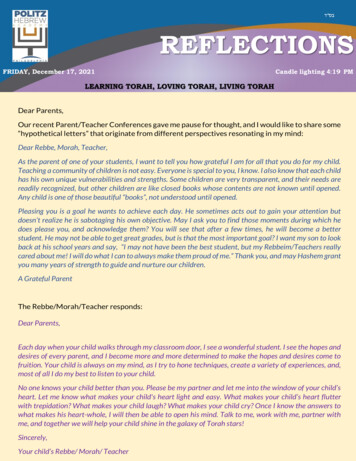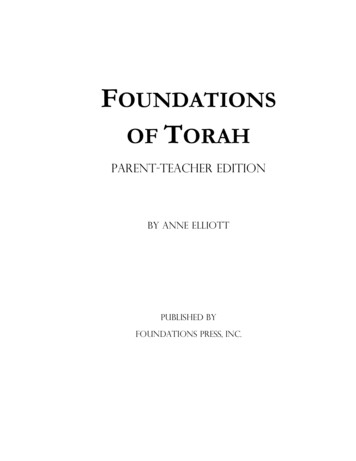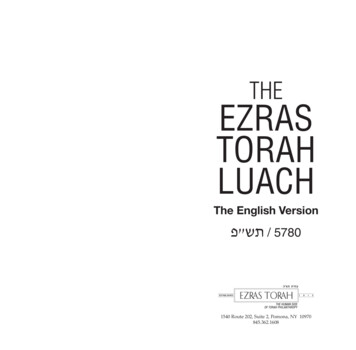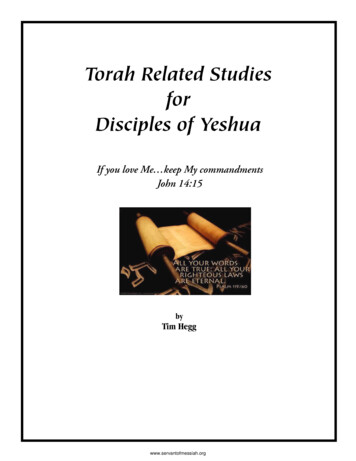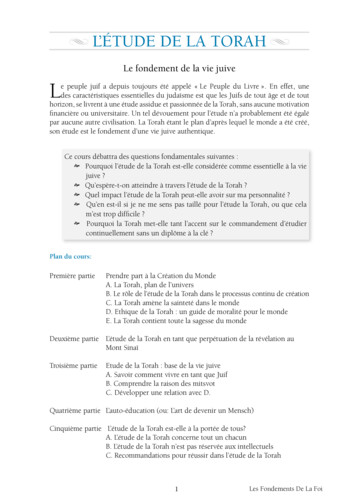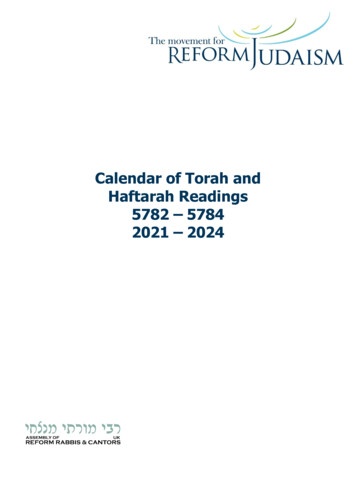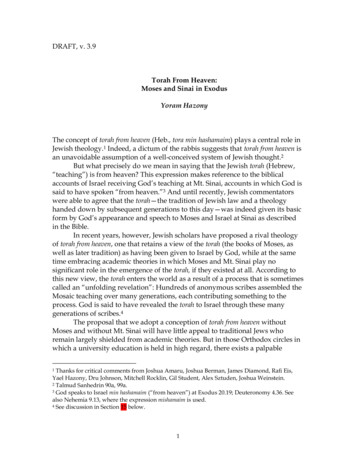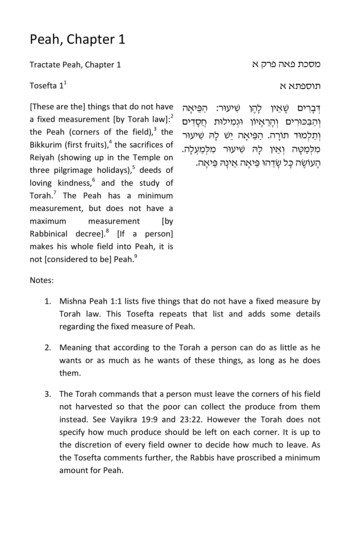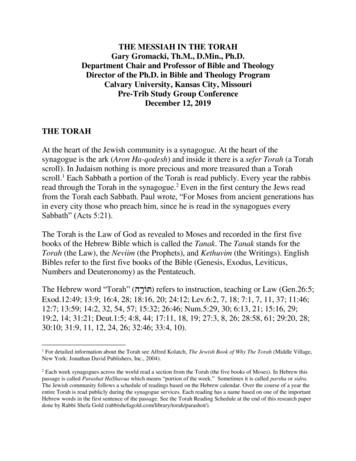
Transcription
THE MESSIAH IN THE TORAHGary Gromacki, Th.M., D.Min., Ph.D.Department Chair and Professor of Bible and TheologyDirector of the Ph.D. in Bible and Theology ProgramCalvary University, Kansas City, MissouriPre-Trib Study Group ConferenceDecember 12, 2019THE TORAHAt the heart of the Jewish community is a synagogue. At the heart of thesynagogue is the ark (Aron Ha-qodesh) and inside it there is a sefer Torah (a Torahscroll). In Judaism nothing is more precious and more treasured than a Torahscroll.1 Each Sabbath a portion of the Torah is read publicly. Every year the rabbisread through the Torah in the synagogue.2 Even in the first century the Jews readfrom the Torah each Sabbath. Paul wrote, “For Moses from ancient generations hasin every city those who preach him, since he is read in the synagogues everySabbath” (Acts 5:21).The Torah is the Law of God as revealed to Moses and recorded in the first fivebooks of the Hebrew Bible which is called the Tanak. The Tanak stands for theTorah (the Law), the Neviim (the Prophets), and Kethuvim (the Writings). EnglishBibles refer to the first five books of the Bible (Genesis, Exodus, Leviticus,Numbers and Deuteronomy) as the Pentateuch.The Hebrew word “Torah” ( )תֹּור ָ֣ה refers to instruction, teaching or Law (Gen.26:5;Exod.12:49; 13:9; 16:4, 28; 18:16, 20; 24:12; Lev.6:2, 7, 18; 7:1, 7, 11, 37; 11:46;12:7; 13:59; 14:2, 32, 54, 57; 15:32; 26:46; Num.5:29, 30; 6:13, 21; 15:16, 29;19:2, 14; 31:21; Deut.1:5; 4:8, 44; 17:11, 18, 19; 27:3, 8, 26; 28:58, 61; 29:20, 28;30:10; 31:9, 11, 12, 24, 26; 32:46; 33:4, 10).1For detailed information about the Torah see Alfred Kolatch, The Jewish Book of Why The Torah (Middle Village,New York: Jonathan David Publishers, Inc., 2004).2Each week synagogues across the world read a section from the Torah (the five books of Moses). In Hebrew thispassage is called Parashat HaShavua which means “portion of the week.” Sometimes it is called parsha or sidra.The Jewish community follows a schedule of readings based on the Hebrew calendar. Over the course of a year theentire Torah is read publicly during the synagogue services. Each reading has a name based on one of the importantHebrew words in the first sentence of the passage. See the Torah Reading Schedule at the end of this research paperdone by Rabbi Shefa Gold (rabbishefagold.com/library/torah/parashot/).
2The written Torah refers to the first five books written by Moses. The oral Torahrefers to the interpretation of the Torah handed down from generation to generationand now found in the Talmud.3The Hebrew titles of the books of the Torah come from the first words of eachbook.The Hebrew title for Genesis is אשׁית ִ֖ ( בְּ ֵר Bereshit In the Beginning) which is thefirst word of Genesis 1:1. Genesis 1:1 says “In the beginning God created theheavens and the earth.” The English title Genesis comes from the GreekΓΕΝΕΣΙΣ which means Creation. The book of Genesis is a book of Beginningsand describes Creation in Genesis 1-2.The Hebrew title for Exodus is מֹות ֙ ( ְשׁ Shemot Names). Exodus 1:1 says “Nowthese are the names of the children of Israel who came to Egypt ” The wordExodus is from the Greek word ΕΞΟΔΟΣ which means “way out.” The book ofExodus is Israel’s exit from Egypt.The Hebrew title for Leviticus is ( וַיּקְ ִ֖רא Vayicra And He called). Leviticus 1:1says “Now the LORD called to Moses and spoke to him from the tabernacle ofmeeting saying.” The word Leviticus is from the Greek word ΛΕΥΙΤΙΚΟΝ andmeans “Relating to the Levites.” The book of Leviticus gives the duties for theLevites as they helped lead Israel in their worship of YHWH.The Hebrew title for Numbers is ( בְּ מ ְד ַבַּ֥ר Bamidbar In the wilderness). Numbers1:1 says “Now the LORD spoke to Moses in the wilderness of Sinai, in thetabernacle of meeting ” God told Moses to “Take a census” (Numbers 1:2). Theword Numbers is taken from the Greek word ΑΡΙΘΜΟΙ and means “Numbers.”Moses numbered all the men of Israel who were 20 years old and older and thetotal number was 603,550 men (excluding the Levites- cf. Numbers 2:32-33).The Hebrew title for Deuteronomy is ( ְדּב ִ֗רים Devarim Words). Deuteronomy 1:1says “These are the words that Moses spoke to all Israel on this side of the Jordanin the wilderness in the plain ” The word Deuteronomy is taken from the Greekword ΔΕΥΤΕΡΟΝΟΜΙΟΝ and means “Second Law.” Rather than a second lawThe Talmud has two components: the Mishnah (Rabbinic Judaism’s Oral Torah) and the Gemara (a commentaryon the Mishnah). The Talmud contains Jewish civil and ceremonial laws including interpretations of the law byvarious rabbis. There are two versions of the Talmud: the Babylonian Talmud and the Jerusalem Talmud.3
3Moses reiterated the Law given to him on Mt. Sinai for the second generation ofIsraelites as they were about to enter the Promised Land.The Torah begins with the account of creation in Genesis 1-2. The Torah ends withthis summary: “But since then thee has not arisen in Israel a prophet like Moses,whom the Lord knew face to face, in all the signs and wonders which the LORDsent him to do in the land of Egypt, before Pharaoh, before all his servants, and inall his land, and by all that mighty power and all the great terror which Mosesperformed in the sight of all Israel” (Deut. 34:10-12). The last word of the Torahis the word “Israel” (Deut. 34:12).The book of Genesis tells how the Creator God made a covenant with Abraham,Isaac and Jacob in which he promised them a land, seed and blessing. The book ofExodus tells how God delivered Israel from Egypt, led the nation to Mount Sinaiwhere God gave them the Law. The book of Leviticus reveals how the priests andLevites were to lead the people to worship a holy God as they offered sacrificesand observed feasts. The book of Numbers explains how the nation of Israelrebelled at Kadesh Barnea and how the Exodus generation was forced to wander inthe wilderness where most died. The book of Deuteronomy was the last message ofMoses to the next generation of Israel in which he repeated the commands of theLaw and challenged them to love and obey YHWH- their covenant keeping God.JESUS AND THE TORAHJesus believed in the authority of the Torah (Matthew 4:1-11)After his baptism by John the Baptist in the Jordan river, Jesus was led by theSpirit into the wilderness of Judea to be tempted by the devil. Jesus fasted for fortydays and forty nights. When he was most vulnerable Satan tempted Jesus to use hispower to turn stones into bread (Matt.4:1-3), to jump off the pinnacle of the temple(Matt.4:5-6) and finally to bow down to worship him to receive the kingdoms ofthis world (Matt.4:8-9). Three times Jesus quoted verses from the book ofDeuteronomy (Matt.4:4 – Deut.8:3; Matt.4:7 –Deut.6:16; Matt.4:10 – Deut.6:13).Three times Jesus said, “It is written.” The fact that Jesus quoted fromDeuteronomy shows that he had memorized the Torah (or at least the book ofDeuteronomy). Jesus knew the Torah and recognized its authority as He obeyed it.
4How did Jesus know the written word of God? The Jews in Nazareth wereastonished at the teaching of Jesus in the synagogue and said “Where did this Manget this wisdom and these mighty works?” (Matt. 13:54). The Jews in Jerusalemcriticized Jesus and asked “How does this Man know letters, having neverstudied?” (John 7:15). Since the gospels do not tell us it is best not to conjecture,but if I were to guess I would suppose that Joseph and Mary taught Jesus the Torahand took him as a young boy to the synagogue where he learned how to read andwrite Hebrew from the Torah.Jesus came to fulfill the Torah (Matthew 5:17-18)In the Sermon on the Mount Jesus explained his relationship to the Old Testament.Jesus said, “Do not think that I came to destroy the Law or the Prophets. I did notcome to destroy but to fulfill. For assuredly I say to you, tell heaven and earth passaway, one jot or one tittle will by no means pass from the law till all is fulfilled”(Matt.5:17-18). Jesus believed in the verbal, plenary inspiration of the OldTestament (the Tanak). The word “jot” refers to the smallest letter in the Hebrewalphabet – the yodh. The word “tittle” refers to the smallest stroke of a Hebrewletter. The difference between the Hebrew letters rhesh and a dallet is a tittle. Jesuscame to fulfill all the Torah.Jesus believed that Moses wrote about him in the Torah (John 5:45-47)The Jewish rulers did not accept Jesus. They persecuted Jesus and tried to kill himbecause he did many of his miracles on the Sabbath (John 5:16). But Jesus rebukedthem and said, “I have come in my Father’s name, and you do not receive me. Ifanother comes in his own name, him you will receive. How can you believe, whoreceive honor from one another, and do not seek the honor that comes from theonly God? Do not think that I shall accuse you to the Father; there is one whoaccuses you- Moses, in whom you trust. For if you believed Moses, you wouldbelieve me for he wrote about Me. But if you do not believe his writings, how willyou believe my words?” (John 5:43-47)
5The protasis (“if” clause) states “For if you believed Moses.” This is a second classcondition in Greek.4 In reality they did not believe Moses even though they werethe teachers of the Law of Moses. The apodasis (“then” clause) is “you wouldbelieve me for he (Moses) wrote of me.” Notice the reason why they should havebelieved in Jesus. Moses wrote about Jesus when Moses gave prophecies about theMessiah in the Torah. Jesus was claiming to be the Messiah that Moses wroteabout in the Torah!The risen Jesus explained to the two disciples on the road to Emmaus how theOld Testament prophecies pointed to himself (Luke 24:25-27)After Jesus arose from the dead he appeared to two disciples on the road toEmmaus. They did not recognize him. Jesus asked them what happened inJerusalem over the weekend. And they said that Jesus of Nazareth was a Prophetmighty in word and deed before God and all the people. The chief priests andrulers of the people delivered Him to be condemned to death and crucified him.You can hear the disappointment in their words: “But we were hoping that it washe who was going to redeem Israel” (Luke 24:21). They then explained how somewomen told them that they had seen a vision of angels who said that Jesus wasalive. But they were leaving Jerusalem- why would they do that? Jesus rebukedthem and said, “O foolish ones and slow of heart to believe in all that the prophetshave spoken? Ought not the Christ to have suffered these things and to enter intoHis glory? (Luke 24:25-26)Luke then writes: “And beginning at Moses and all the Prophets He expounded tothem in all the Scriptures the things concerning Himself” (Luke 24:27). The Greekword “expounded” (διερμήνευσεν) means to clarify, explain or interpret so as tomake understandable.5 Jesus explained to these two disciples on the road toEmmaus how the Old Testament prophecies pointed to the Messiah. Jesus startedwith the books written by Moses (the Torah). Jesus believed in the Mosaicauthorship of the Torah.Wallace writes: “The second class condition indicates the assumption of an untruth (for the sake of argument). Forthis reason it is appropriately called the ‘contrary to fact’ condition (or the unreal condition). It might be better tocall it presumed contrary to fact, however, since sometimes it presents a condition that is true, even though thespeaker assumes it to be untrue.” (Wallace, Greek Grammar Beyond the Basics [Grand Rapids: Zondervan, 1996],694).4Frederick William Danker, A Greek –English Lexicon of the New Testament and Other Early Christian Literature,3rd edition (Chicago: University of Chicago Press, 2000) 244.5
6Later that day the two men stopped and invited Jesus to dinner. When Jesus tookbread, he blessed it and then broke the bread. When the two men realized it wasJesus, he vanished from their sight (Luke 24:30-31). The two disciples said, “Didnot our hearts burn within us while He talked with us on the road and while Heopened the Scriptures to us?” (Luke 24:32).The risen Jesus told his disciples about the necessity of the fulfillment of OldTestament prophecy (Luke 24:44-45)Later that night the risen Jesus appeared to the eleven disciples who were in hidingin Jerusalem. Jesus showed them his hands and feet (Luke 24:40). Then Jesus atesome broiled fish and some honeycomb to prove that he was not a ghost (Luke24:42). Then Jesus said to the disciples, “These are the words which I spoke to youwhile I was still with you that all things must be fulfilled which were written in theLaw of Moses (ἐν τῷ νόμῳ Μωϋσέως) and the Prophets and the Psalmsconcerning Me. And he opened their understanding that they might comprehendthe Scriptures.” (Luke 24:44-45)MESSIANIC PROPHECIES IN THE TORAHGenesis 3:15 – Seed of the Woman“So the LORD God said to the serpent: ‘Because you have done this, you arecursed more than all cattle and more than every beast of the field; on your bellyyou shall go and you shall eat dust all the days of your life. And I will put enmitybetween you and the woman; and between your seed and her Seed; He shall bruiseyour head, and you shall bruise His heel” (Gen. 3:14-15).After Adam and Eve sinned against God, God pronounced judgments on theserpent, on the woman and on the man (Gen.3:14-19). God placed a curse on theserpent and not on the man or the woman. The serpent was not given anopportunity to explain its actions like the man and woman. The serpent wasimmediately judged by God. The serpent’s judgment was to crawl on its belly andto eat dust all the days of its life. The physical form of the serpent was changed insome way as a result of this curse. Possibly before the Fall the serpent had legs ofsome kind. Now it would slither on the ground. Eating dust is symbolic ofhumiliation and defeat. Isaiah 65:25 tells us that in the future millennial kingdomthe wolf and lamb will eat together and not each other, the lion will eat straw likethe ox and the serpent will eat dust. The entire animal kingdom was impacted by
7the Fall as evidenced by the fact that the serpent was cursed more than all cattleand more than every beast of the field (Gen.3:14; Rom.8:20).6The serpent is more than just a physical snake.7 The fact that the serpent talked tothe woman has led many to conclude that the Bible is a myth. The snake waspossessed by Satan. The apostle Paul wrote: “But I fear, lest somehow as theserpent deceived Eve by his craftiness, so your minds may be corrupted from thesimplicity that is in Christ.” The apostle John identified the serpent with Satan: “Sothe great dragon was cast out, that serpent of old, called the Devil and Satan, whodeceives the whole world; he was cast to the earth, and his angels were cast outwith him” (Rev.12:9)God predicted a conflict between the serpent and the woman and between theserpent’s seed and the woman’s seed. A review of biblical history shows theconflict between the two seeds. Satan influenced Cain to kill his brother Abel(Gen.4:1-15). Why did Cain his brother Abel? John explained that Cain was of theevil one (1 John 3:12). Satan tried to corrupt the seed of the woman as the sons ofGod married the daughters of men and had children by them (Gen. 6).8 Pharaohtook Abraham’s wife Sarai and endangered the promise but God stopped him fromhaving sexual relations with her (Genesis 12). Abimelech took Sarah but Godstopped him from having sexual relations with her as well (Genesis 20). Pharaohordered that all the Jewish boy babies to be thrown into the Nile river (attempt atgenocide) but the Jewish midwives refused to obey his command (Exodus 1).Haman tried to have all the Jews executed by order of the King of Persia. ButEsther learned of the plot from Mordecai and Haman was hung on his own gallows(book of Esther).Jesus is the Seed of the woman. He was born of the virgin Mary in fulfillment ofthe direct Messianic prophecy of Isaiah 7:14: “Behold, the virgin shall conceiveMatthews writes, “Curses are uttered against the serpent and the ground, but not against the man and the woman,implying that the blessing has not been utterly lost. It is not until human murder, a transgression against the imagoDei, that a person (Cain) receives the divine curse” (Matthews, Genesis 1-11:26, 243).67Michael Rydelnik gives a detailed explanation of Genesis 3:15 as a Messianic prophecy in his book The MessianicHope: Is the Hebrew Bible Really Messianic? (Nashville: B&H Publishing Group, 2010). See especially chapter 9“An Example from the Law: Interpreting Genesis 3:15 as a Messianic Prophecy” (p.129-145).See Arnold Fruchtenbaum, Ariel’s Bible Commentary: The Book of Genesis (Ariel Ministries, 2009), 143-152 forthe view that the sons of God were demons who intermarried women who gave birth to the Nephilim. This wasSatan’s attempt to prevent the Messiah from coming through the seed of the woman.8
8and bear a Son, and shall call his name Immanuel.” Matthew emphasized in hisgospel that the Mary was pregnant with a child before she came together with herhusband Joseph. He wrote: “Now the birth of Jesus Christ was as follows: AfterHis mother Mary was betrothed to Joseph, before they came together, she wasfound with child of the Holy Spirit .So all this was done that it might be fulfilledwhich was spoken by the Lord through the prophet, “Behold the virgin shall bewith child, and bear a Son, and they shall call his name Immanuel” which istranslated “God with us” (Matthew 1:18, 22-23).9Paul emphasized that Jesus was the Son who was “born of a woman” as he wrote:“But when the fullness of time had come, God sent forth His Son, born of awoman, born under the law to redeem those who were under the law, that we mightreceive the adoption as sons” (Galatians 4:4-5). Robert Gromacki writes, “Themeans of the incarnation was through the virgin birth (“made of a woman”).Several evangelicals argue that this statement only demonstrates that Christ had acomplete and perfect humanity. Paul, however, later used a different verb to depictnatural birth (gennao; 4:23). The verb “made” (genomenon) is used elsewhere ofChrist’s incarnation: And the Word was made flesh” (John 1:14). He was thepromised seed of the woman who would destroy Satan (Gen.3:15).”10King Herod (who was of the spiritual seed of Satan) tried to have Jesus killed whenhe was born. He ordered all the boy babies two years of age and younger in thevicinity of Bethlehem to be executed. But God warned Joseph in a dream and hetook Mary and the young Jesus to Egypt to escape King Herod (Matt.2:1-19).Jesus was crucified on the cross and it appeared as if Satan had won the victorywith the death of Jesus. But the protoevangelium (the first mention of the gospel)found in Genesis 3:15 predicted that the seed of the woman would crush theserpent’s head and the serpent would bruise his heel. The picture is of someonestomping on a snake. The snake bites the heal of the person who crushes its head.Jesus crushed the serpent’s head (defeated the devil) by his death on the cross. Thecross was not the defeat of Jesus but the defeat of the devil!Colossians 2:14-15 emphasizes the victory of Jesus on the cross stating that Jesushas “wiped out the handwriting of requirements that was against us, which was9For a detailed study of the virgin birth of Jesus see Robert Gromacki, The Virgin Birth, Revised and Updated(Grand Rapids: Kregel Academic, 2002).10Robert Gromacki, Stand Fast in Liberty (The Woodlands, Texas: Kress Christian Publications, 2002), 123.
9contrary to us. And He has taken it out of the way, having nailed it to the cross.Having disarmed principalities and powers, He made a public spectacle of them,triumphing over them in it.”Hebrews 2:14-15 says “Inasmuch as the children have partaken of flesh and blood,He himself likewise shared in the same, that through death He might destroy himwho had the power of death, that is, the devil and release those who through fear ofdeath were all their lifetime subject to bondage.”Genesis 22:18 – Seed of AbrahamThe Messiah would be of the Seed of Abraham. God promised Abram that “In youall the families of the earth shall be blessed” (Gen.12:3b). God reiterated thepromise to give Abram’s descendants the land after Abram obeyed the call of God(Gen.12:4-7). God promised to give Abram and his descendants the land and tomultiply his descendants as the dust of the earth (Gen.13:14-16). God showedAbram the stars and promised to multiply Abram’s descendants as the number ofthe stars (Gen.15:1-5). Abram believed in the LORD and his promise and Godcounted it to him as righteousness (Gen.15:6). In the Abrahamic covenant Godpromised the land to Abram’s descendants (Gen.15:18-21). Later God promisedAbraham that kings would come from him and that the land would be given as aneverlasting possession to his descendants (Gen.17:5-8). God promised Abraham“In your seed all the nations of the earth will be blessed” (Genesis 22:18).Jesus is the Seed of Abraham. Jesus is a Jew – a physical descendant of Abraham,Isaac, and Jacob. Matthew begins his gospel with these words: “The book of thegenealogy of Jesus Christ, the Son of David, the Son of Abraham” (Matthew 1:1).The Gospel According to Matthew is the Gospel of the King and he shows howJesus is the Messiah who fulfilled these various Old Testament prophecies.The Messiah would be born of a virgin (Isaiah 7:14; Matthew 1:23)The Messiah would be born in Bethlehem (Micah 5:2; Matthew 2:6)The Messiah would come out of Egypt (Hosea 11:1; Matthew 2:15)The Messiah would have a forerunner (Isaiah 40:3; Matthew 3:3; 11:10)The Messiah would minister in Galilee (Isaiah 9:1-2; Matthew 4:15-16)The Messiah would perform miracles of healing (Isaiah 53:4; Matthew 8:17)The Messiah would be humble (Isaiah 42:1-4; Matthew 12:17-18)The Messiah would speak in parables (Isaiah 6:9-10; Matthew 13:35)The Messiah would offer himself as King (Zechariah 9:9; Matthew 21:5)
10The Messiah would be betrayed (Zechariah 11:12-13; Matthew 27:9-10)The Messiah would experience suffering (Psalm 22:1; Matthew 27:35)The apostle Paul identified Jesus as the Seed of Abraham in his epistle to theGalatians. Paul wrote: “Brethren, I speak in the manner of men: Though it is only aman’s covenant, yet if it is confirmed, no one annuls or adds to it. Now toAbraham and his Seed were the promises made. He does not say “And to seeds,”as of many, but as of one, “And to your Seed,” who is Christ” (Gal. 3:15-16). TheAbrahamic covenant is an unconditional, unilateral covenant. Paul interprets thetext in Genesis to teach that the covenant promise concerns not many seeds (plural)but one singular Seed (a reference to Christ). All the nations will be blessedthrough Christ. This promise will be literally fulfilled in the future millennialkingdom as Christ sits on the throne of David and rules over the world.11Genesis 35:10-12 – Son of JacobGod repeated the promise to Jacob when God changed his name to Israel(Gen.35:10). God said to Jacob, “I am God Almighty. Be fruitful and multiply; anation and a company of nations shall proceed from you and kings shall come fromyour body; The land which I gave Abraham and Isaac I give to you and to yourdescendants after you I give this land” (Gen.35:11-12).The genealogies of Jesus show that both Joseph (his adoptive father) and Mary (hismother) were Jews – physical descendants of Abraham, Isaac and Jacob. SeeMatthew 1:1-2 and Luke 3:23, 34.Genesis 49:10 – Ruler out of tribe of JudahMoses wrote that Jacob blessed his son Judah (Gen.49:8-12). Jacob comparedJudah to a lion and predicted that a ruler would come from his tribe. “The sceptershall not depart from Judah, nor a lawgiver from between his feet, until Shilohcomes. And to Him shall be the obedience of the people” (Gen.49:10).Jacob predicted that the Messiah would come from the tribe of Judah. The Messiahwould be a king (a ruler). The word scepter (֙ )שֵׁ בֶ ט appears for the first time inScripture here in Genesis 49:10. The word is used of a rod of discipline (Exod.Gary Gromacki, “A Critique of the Use of Galatians 3 in the Theological Systems of A. Pieters, D. Fuller, and A.Hoekema” Th.M thesis (Dallas Theological Seminary, 1984).11
1121:20) and a rod or staff that could separate sheep for the Lord’s tithe (Lev.27:32).The word also appears in the messianic passage from the oracles of Balaam (Num.24:17).The first sign of the removal of the scepter from Judah was that no king from theline of Judah sat on the Davidic throne after Nebuchadnezzar and the Babyloniansdestroyed the temple and Jerusalem and took the Jews into captivity in 586 B.C.The Romans under Pompey conquered Israel in 63 B.C. Later the Romansappointed Herod (an Idumean) as king of the Jews which was around 40 B.C. Itappeared as if the prophecy of Genesis 49:10 could not be fulfilled. Later after thedestruction of Jerusalem and the temple in A.D. 70 by Titus and the Romans theJews were taken into captivity again and Judah lost its royal or legal power as anation. Again it appeared as if the prophecy of Genesis 49:10 could not befulfilled. No wonder King Herod and all Jerusalem were troubled when the wisemen came to Jerusalem and asked the question “Where is He who has been bornKing of Jews? For we have seen His star in the East and have come to worshipHim” (Matt.2:2).The word “Shiloh” is not a proper name for Messiah but is best translated as apossessive pronoun. The NIV translates “ שׁ ִיֹלה until he comes to whom itbelongs.” Fruchtenbaum writes “A more literal translation of the verse shouldread: ‘The scepter will not depart from Judah, nor the ruler’s staff from betweenhis feet, until he comes whose right it is and unto him shall the obedience of thepeoples be.’ Judah’s identity and right to rule cannot be lost until one comes whohas full rights to the scepter, full rights to rule.”12King David was from the tribe of Judah and God promised David in the DavidicCovenant that one of his descendants would sit on the throne of David and ruleIsrael forever (2 Sam. 7:16).Jesus is the rightful king of Israel as he is a physical descendant of David throughMary. The angel Gabriel told Mary about her son Jesus: “He will be great and willbe called the Son of the Highest, and the Lord God will give Him the throne of hisfather David. And he will reign over the house of Jacob forever, and of Hiskingdom there will be no end” (Luke 1:32-33). Later Mary praised God for Hisfulfillment of the Abrahamic covenant through Jesus: “He has helped his servantIsrael in remembrance of his mercy. As he spoke to our fathers to Abraham and tohis seed forever” (Luke 1:54-55).12Arnold Fruchtenbaum, Messianic Christology (Ariel Ministries, 1998), 21.
12We find two genealogies of Jesus in the gospels. Why two genealogies of Jesus ifJesus was born of the virgin Mary? The genealogy of Jesus in the gospel ofMatthew (Matt. 1:1-17) focuses on the line of Joseph. This genealogy shows howJesus has the legal right to rule Israel. The genealogy begins with Abraham andends with Christ. It traces the line of David through Solomon. The genealogy goesfrom father to son. It lists 41 names. The genealogy can be divided into threesections of 14 names each: Abraham to David (Matt.1:2-6), David to the exile inBabylon (Matt.1:6-11), and the exile in Babylon to Jesus (Matt.1:12-16). The rightto rule Israel was passed from David to his son Solomon. The last king mentionedbefore the exile in Babylon is Jeconiah.God placed a curse on Jeconiah because of his wickedness. God said that none ofJeconiah’s sons would reign as king (Jer.22:24, 28, 30). Jeconiah had children butthey did not reign as king over Israel or Judah. There has not been a king of Judahsit on the throne of David since 586 B.C. when Nebuchadnezzar and theBabylonians took the Jews into captivity.13The right to rule Israel as king was passed from father to son. That right waspassed from David to Solomon down to Jeconiah. The curse placed on Jeconiahand his line caused a dilemma for the nation of Israel. Who could reign as thelegitimate king of Israel if the line of David was cursed? Joseph was a physicaldescendent of David and Jeconiah. Now we understand why Joseph was acarpenter and not the king of Israel. Joseph did have the legal right to rule as king.But he could not rule since he was the physical descendent of Jeconiah.So what was the solution to the problem? The virgin birth of Christ is the solutionto the curse!! Matthew writes that “Jacob begot Joseph the husband of Mary, ofwhom was born Jesus who is called the Christ” (Matt. 1:16). The Greek relativepronoun ἧς is feminine in gender and refers back to Mary. Jesus was born “out ofher” (ἐξ ἧς) – a reference to Mary (a physical descendent of King David throughanother son of David- Nathan). Jesus received the physical right to rule Israelthrough Mary. He is a literal physical descendant of David with royal blood in hisveins. The genealogy of Jesus in Luke 3:23-38 is really the genealogy of Jesusthrough his mother Mary.Joseph passed the legal right to rule Israel by naming Jesus as his adopted son.Notice that the angel of the Lord told Joseph to take Mary as his wife, that she13Gary Gromacki, “The Times of the Gentiles” The Journal of Ministry and Theology (Spring 2017), 5-49.
13would bring forth a son, and he (Joseph) was to call his name Jesus. Josephobeyed. He took Mary into his home and did not know her until she gave birth toJesus. Then “he called his name Jesus” (Matt.1:25). This is why the twogenealogies of Jesus are necessary. Only Jesus can prove that he has the legal andphysical right to rule Israel and sit on David’s throne as king.Fruchtenbaum refers to the Genesis 49:10 prophecy as he writes, “Third, it shouldbe seen that Messiah will have to come before the Tribe of Judah loses its identity.This establishes a clear time period for the prophecy. The records by which tribalidentities were maintained were kept in the Jewish temple. All of these recordswere lost with the destructio
THE TORAH At the heart of the Jewish community is a synagogue. At the heart of the synagogue is the ark (Aron Ha-qodesh) and inside it there is a sefer Torah (a Torah scroll). In Judaism nothing is more precious and more treasured than a Torah scroll.1 Each Sabbath a portion of the Torah is read publicly. Every year the rabbis


